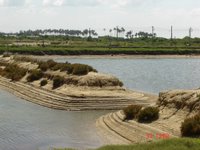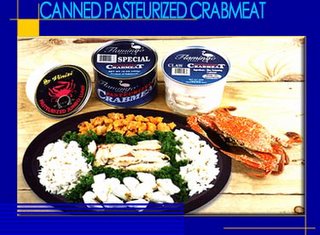
The prawns at the top and right of the picture shows the pick body colour typical for the acute phase of infetcion. The bottom and the left hand side pictute shows the classical White Spot Diseased after the acture phase
For most of you who are not familiar to the topic of Aqua Culture Industry this would sound as an unfamiliar term, but for the one’s engage in the industry this would be a term which bring back some horrible memories. To be straight forward this is the diseases that made a big lost and damaged to the shrimp culturing industry which brought lot of foreign exchange to the county as well as kept remain 80% of net profit within the country of its exports. Many countries which exported in volume base in South Asian Region such as India, Sri Lanka, Thaiwan, Vitenam etc got affected by this horrible disease and there were many people wiped out from this aqua culturing industry.
The early 90’s was the period where the prawn farming came to the climax for anyone looking at it at a glance would be seen as a mine of gold.  During this period a few major exporters dominated the marketplace and earned huge amount of profits. During this period more than 4000 acres of land were used for the aquaculture. Almost all the lands which was suitable for prawn faming was utilised at this stage. But with the government change in the year of 1994 the supporters of the newly elected government by force acquired the reservation lands and started to do the farming. Due to this factor within one year the land used for farming skyrocketed to 12000 acres. And the hatcheries used to produce the baby prawns mushroomed from 4 to more than 100. But sufficient qualified personnel needed for the maintenance of these hatcheries were not to be found in Sri Lanka and most of the hatcheries maintained a very low standard in terms of the quality. Furthermore the water supply to those farms was mainly from the lagoons through the canals such as Hamilton Canal using the high and the
During this period a few major exporters dominated the marketplace and earned huge amount of profits. During this period more than 4000 acres of land were used for the aquaculture. Almost all the lands which was suitable for prawn faming was utilised at this stage. But with the government change in the year of 1994 the supporters of the newly elected government by force acquired the reservation lands and started to do the farming. Due to this factor within one year the land used for farming skyrocketed to 12000 acres. And the hatcheries used to produce the baby prawns mushroomed from 4 to more than 100. But sufficient qualified personnel needed for the maintenance of these hatcheries were not to be found in Sri Lanka and most of the hatcheries maintained a very low standard in terms of the quality. Furthermore the water supply to those farms was mainly from the lagoons through the canals such as Hamilton Canal using the high and the low tide of the sea. But due to the excess land capacity the water systems started to malfunction and the polluted water got stagnated in many of the prawn farms giving the chance for diseases to generate and kill the prawns. At the end the disease affected the whole South Asia to a considerable extent making a great loss to the country’s foreign income generation.
low tide of the sea. But due to the excess land capacity the water systems started to malfunction and the polluted water got stagnated in many of the prawn farms giving the chance for diseases to generate and kill the prawns. At the end the disease affected the whole South Asia to a considerable extent making a great loss to the country’s foreign income generation.
The blame of this devastation could be finger pointed directly at the government which was so inefficient both pre & post to the disease. Normally for a business of this nature the quality standards plays as the fundamental theme for success. But when the new suppliers mushroomed the government did very little checking into the quality standards of them both at the start up stage and when they are moving on with the operation. But at the end due to the determination of few of the original suppliers still the industry is running and showing signs of the good days again with the continues demand increase in the last few years.
So by now onwards at least if the government can look forward and get their acts together and give the best support to the industries as these which has a very high growth potential Sri Lanka would develop to a much higher state.
 The trend in the world for the last few decades was to move back to the natural products; organic products, hybrid cars, etc... And the sea food in most parts of the world could be identified as one of the most preferred choices of the people who prefer the natural products. There is a belief in most of them that the fish products give the best nourishment in all the meat products which we consume.
The trend in the world for the last few decades was to move back to the natural products; organic products, hybrid cars, etc... And the sea food in most parts of the world could be identified as one of the most preferred choices of the people who prefer the natural products. There is a belief in most of them that the fish products give the best nourishment in all the meat products which we consume.  for the sea food industry in
for the sea food industry in 
























